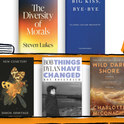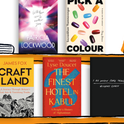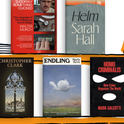“Originality is not and never has been the vital ingredient in children’s literature,” writes Sam Leith in The Haunted Wood, in response to critics who have sniffily dismissed JK Rowling’s Harry Potter novels as derivative. In this magisterial and wonderfully entertaining overview of the history of (mainly British) children’s literature, he demonstrates how deep and primal are the fears and longings it expresses. Although their forms differ by era, all children’s tales—which are really tales for everyone—have a common goal, which is to reveal the deep, joyous, mysterious realities of the world.
Leith, whose range of reference is impressively vast, quotes the Soviet folklorist Vladimir Propp, whose master project was to categorise folk stories into a minutely calibrated range of subgenres. The seven members in Propp’s dramatis personae of folktale archetypes—villain, donor, helper, princess, dispatcher, hero and false hero—can all be thrown together in ways and stories as varied as life itself. How often do we remake the story of Cinderella or Snow White or the Little Mermaid? Then there are secrets, doors, gardens, locked caskets and the mysteries of adulthood. There are magic instruments and special powers, dark woods, intimidating castles and mean streets. There are roads leading to adventure for a traveller walking with his or her belongings in a handkerchief on a stick, or riding a bicycle or in the back of a car or in a hot air balloon. The journey is always onward, helped perhaps by an avatar of knowledge, a talking animal, a chance encounter with someone unusual or magical or supernatural.
This robust freedom is encouraged in children’s stories, which is why one of the first tasks of the writer is to work out what to do with the adults. In the 19th and 20th centuries, parents were killed off or sent to India or perhaps rendered inactive due to convalescence; children lived in orphanages or with horrible aunts, arrangements which today can be reimagined as boarding school or foster care. “Once upon a time,” is the beguiling portal to the narrative, but what time that is doesn’t matter: the story is for any time and all time.
Leith dates what might be thought of as the very first piece of narrative written explicitly for children to a fragment of papyrus unearthed in Oxyrhynchus, Egypt. It is a few lines about Hercules, written in larger-than-usual characters—easy to decipher for a novice reader. More familiar to us today are the fables of Aesop, a slave living in around 600BC. From Aesop, we get the tortoise and the hare, the town mouse and the country mouse, and the goose that laid the golden eggs: didactic nuggets wrapped in tales of talking animals. It is the first instance in Leith’s account of what he calls children’s literature’s “tug of war between instruction and delight”. But it’s the delight in Aesop’s fables that gives them their staying power. The first published children’s book, John Amos Comenius’s Orbis Sensualium Pictus, appeared in 1658, with an irresistible invitation to its young reader: “Come boy, learn to be wise.” (Girls, at this stage, must wait their turn.) It’s a book about the known world, its geography and features, its animals and plants—lists and categorisations, the naming of names and the sorting of phenomena.
Comenius’s book is about the wonders of the world as it is—and for children, what is can be as magical as what might be imagined. But what did childhood mean to its author? Certainly, it would not have looked to him as it looks to us today. In 16th- and 17th-century portraits, we see tiny tots dressed in doublets and farthingales, imitation grownups in miniature sizes. A medieval child was put to work and married (or at least betrothed) as soon as possible. In 1658, the boy opening Orbis Sensualium Pictus would have been regarded as an adult in waiting, a blank slate on which experience and education might productively be poured—in the spirit of John Locke, the 17th-century philosopher whose ideas about the shaping of a young mind (in Locke’s famous definition, a tabula rasa) and recommendations about learning through play, for example, radically refocused ideas on how children can be best directed to flourish as adults.
But it was Jean-Jacques Rousseau, several decades later, who introduced the idea that childhood is not just a stage on the path to adulthood but a distinct state in itself. A Rousseau child can do nothing wrong or right, because he is born in a state of absolute innocence as to what wrong or right might be. It is this belief in a state of unknowing that is so central to the children’s literature that follows—and to the Romantics’ perception of children having blissful engagement with nature and wonder before, as Wordsworth put it, “the shades of the prison house begin to close upon the growing boy”. It is a state forever out of reach to grownups, including the writers of children’s books, who often yearn for it most of all. It is an Eden before the fall, the pre-industrial pastoral idyll of the Shire, the Riverbank, the Hundred Acre Wood. It is also a state of rule-breaking and subversion, of cocking snooks at authority and turning the world on its head in ways that only children can fully understand.
Rousseau introduced the idea that childhood is not just a stage on the path to adulthood but a distinct state in itself
Leith romps through the centuries, prefacing each chapter with a short introduction before chronicling a clutch of authors from the period. He sees the mid-19th century as the “dawning of the golden age”—more specifically, 1865, the very moment when Alice goes down the rabbit hole after the white rabbit. Alice’s adventures represent for the first time in literature an imaginative world in which the idea that nothing is what it seems is the endpoint of the game; everything we adults think we know goes awry in ways that children feel quite comfortable with. Leith quotes the psychologist Alison Gopnik, who uses the term “lantern consciousness” to describe how young children encounter the world: the child doesn’t edit or sort what they see, but casts a light over everything equally. In Alice’s Adventures in Wonderland, the domestic world of tea and babies and home is turned upside down—it is buttered toast, but not as we know it. Leith is very interesting on the “embodied” nature of Alice, her expanding and shrinking self, and how running through Lewis Carroll’s book—written only a few years after the publication of On the Origin of Species—is a sense of the inescapable physicality of selfhood.
Leith sweeps through the moralists, such as Charles Kingsley, whose The Water Babies is far more extraordinarily wacky than its reputation for Victorian piety would suggest, and Thomas Hughes, whose Tom Brown’s School Days is the progenitor of the boarding school novel. Then there are the late Victorians, represented by authors such as Rudyard Kipling (Leith writes gloriously about Kipling’s deliriously inventive and magpie use of language in Kim, the Just So Stories and, later, Stalky & Co.), whose reputation for empire-building jingoism is here triumphantly rehabilitated. The Edwardian writers emerge at a time when children and childhood are seen as more distinct entities than ever before: Beatrix Potter licensed the use of Peter Rabbit to a soft-toy manufacturer in 1903, thus kickstarting the history of storybook merchandising. An intense nostalgia wafts through the works of this period, which include Peter Pan, JM Barrie’s dark and ambivalent story of the boy who can’t grow up. And it is impossible now to read about Peter without thinking of what Barrie did not know in the first years of the 20th century—that among his readers were thousands of boys destined never to grow up.
Each era deals with its own particular generational traumas. The interwar period was a time of intense, even paralysing, grief. Into this pain came Richmal Crompton’s William Brown, an irresistibly subversive creation whose antics Leith describes as “borderline criminality”. It is the era of a new middle class, a newly suburbanised, commuter-belt kind of English domesticity exemplified by the Browns and by PL Travers’s magical nanny, Mary Poppins, arriving in Cherry Tree Lane with her parrot-head umbrella. But it is also the period of the mythic reimaginings of Tolkien (The Hobbit was published in 1937) and TH White’s wild and witty Arthurian fantasy The Sword in the Stone.
During the austerity years of the 1950s, we find the cult of home, a longing for the certainties of an imagined historical past in the alienating shadow of the Cold War and the H-bomb. Here are Lucy Boston’s stories of Green Knowe, the manor house where the children of the past play with the lonely child of the present. And here also is Tom’s Midnight Garden, Philippa Pearce’s story of another lonely boy, this time convalescing with an aunt in a large house that has been turned into flats; when the clock strikes 13, Tom goes back in time to meet the Edwardian children who once lived there. This is the time of CS Lewis’s Chronicles of Narnia, a Christian allegory set in a world turned to ice, where the forces of good and evil battle it out through children who must die rather than grow up. Then there is science fiction, with writers such as Nicholas Fisk, and the kind of sci-fi and fantasy mash-up of the Earthsea books by Ursula K Le Guin. Leith has interesting things to say about the re-enchanted England to be found in the works of Alan Garner, Susan Cooper and Diana Wynne Jones, in which an ancient, half-forgotten folk magic lies just beneath the contours of the landscape or of the domestic world. It’s another version of the parallel universes explored through CS Lewis’s wardrobe or Lewis Carroll’s rabbit hole. Garner’s novels, for example, tap deep into the folkloric past of Alderley Edge in Cheshire, into knowledge he learned from his grandfather, a blacksmith who couldn’t read or write.
Roald Dahl delights, as children do, in nastiness and crude justice
By the time we get to the 1970s and beyond, children’s literature is wildly multifarious, with Leith moving from the affirming realism of Judy Blume’s hugely popular novels about teenagers to Richard Adams’s dystopic and violent depiction of rabbits in Watership Down. Roald Dahl delights, as children do, in nastiness and crude justice, and has a rigorously medieval view of morality—baddies you can spot a mile off because they are ugly. Fat people, for Dahl, are always horrid.
After a detour to Scandinavia and Moominvalley, as well as Astrid Lindgren’s anarchic wonder-girl Pippi Longstocking, we arrive at an age of representation—at how novels begin to address the matter of how readers might see themselves reflected in them. Malorie Blackman’s Noughts and Crosses, for example, imagines a society in which black people comprise the elite and whites the underclass. And Jacqueline Wilson’s Tracy Beaker is a child of foster care and neglect, a knowing, needy, materialistic, money-minded but somehow truly loveable heroine for a new century. And Philip Pullman turns the old, moralising idea of innocence on its head in the His Dark Materials trilogy, in which the “dust” of sinful consciousness, reviled by a malign theocracy, is found to be the opposite of sinful: it is in fact the stuff of life.
Because so many of the books detailed by Leith are written by adults imagining themselves into childhood, unhappiness seems to be disproportionately represented in the lives of the authors of classic children’s literature. Many are, as Leith puts it, “writing from a wound”. Charles Kingsley’s account of the little chimney sweep swept clean by the river is made stranger still by the knowledge that Kingsley, a bewhiskered social reformer and clergyman, was obsessed by cleanliness and, for her edification, sent his wife pictures of naked female saints being tortured. Behind the pen name of Lewis Carroll was Charles Dodgson, a quiet and weedy young mathematician who wrapped his life in as many obscuring dimensions as exist in a rabbit hole adventure. Edith Nesbit had a brute of a husband and was a Fabian who didn’t approve of women’s suffrage. Kenneth Grahame, the creator of Ratty and Mole and Badger and Toad, was emotionally shy and unhappily married; his adored son died by suicide at the age of 20. Jacqueline Wilson has spoken of the unhappiness of her childhood. Harry Potter was JK Rowling’s refuge from an abusive husband. Maurice Sendak (Where the Wild Things Are) was brought up by Jewish parents traumatised by the Holocaust. Kipling’s daughter Effie, the “best beloved” of the Just So Stories, died at the age of six. Most poignant for our own time, which is riven with ambivalence about adulthood and masculinity, is that JM Barrie once scrawled in his notebook: “desperate attempt to grow up but can’t.”
The vast arc of The Haunted Wood teems with literary life. Leith combines a delightfully engaging prose style with erudition and empathy. But even more importantly, the book vividly and infectiously conveys a rapturous excitement for stories that are the foundation stones of our engagement with the world—both real and imagined.












